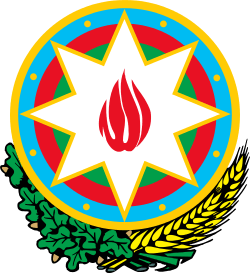Agriculture in Azerbaijan
The primary crops produced in Azerbaijan are agricultural cash crops, grapes, cotton, tobacco, citrus fruits, and vegetables. The first three crops account for over half of all production, and the last two together account for an additional 30 percent. Livestock, dairy products, and wine and spirits are also important farm products.[1]
History
In the early 1990s, Azerbaijan's agricultural sector required substantial restructuring if it was to realize its vast potential. Prices for agricultural products did not rise as fast as the cost of inputs; the Soviet-era collective farm system discouraged private initiative; equipment in general and the irrigation system in particular were outdated; modern technology had not been introduced widely; and administration of agricultural programs was ineffective.[1]
Most of Azerbaijan's cultivated lands, which total over 1 million hectares, are irrigated by more than 40,000 kilometers of canals and pipelines. The varied climate allows cultivation of a wide variety of crops, ranging from peaches to almonds and from rice to cotton. In the early 1990s, agricultural production contributed about 30 to 40 percent of Azerbaijan's net material product, while directly employing about one third of the labor force and providing a livelihood to about half the country's population. In the early postwar decades, Azerbaijan's major cash crops were cotton and tobacco, but in the 1970s grapes became the most productive crop. An anti-alcohol campaign by Moscow in the mid-1980s contributed to a sharp decline in grape production in the late 1980s. In 1991 grapes accounted for over 20 percent of agricultural production, followed closely by cotton.[1]
Production of virtually all crops declined in the early 1990s. In 1990 work stoppages and anti-Soviet demonstrations contributed to declines in agricultural production. The conflict in Nagorno-Karabakh, the site of about one-third of Azerbaijan's croplands, substantially reduced agricultural production beginning in 1989. In 1992 agriculture's contribution to NMP declined by 22 percent. This drop was attributed mainly to cool weather, which reduced cotton and grape harvests, and to the continuation of the Nagorno-Karabakh conflict. The conflict induced blockade of the Nakhichevan Autonomous Republic also disrupted agriculture there.[1]
An estimated 1,200 state and cooperative farms are in operation in Azerbaijan, with little actual difference between the rights and privileges of state and cooperative holdings. Small private garden plots, constituting only a fraction of total cultivated land, contribute as much as 20 percent of agricultural production and more than half of livestock production. Private landholders do not have equal access, however, to the inputs, services, and financing that would maximize their output.[1]
The Ministry of Agriculture of Azerbaijan runs procurement centers dispersed throughout the country for government purchase of most of the tobacco, cotton, tea, silk, and grapes that are produced. The Ministry of Grain and Bread Products runs similar operations that buy a major portion of grain production. Remaining crops are sold in the private sector.[1]
Labor practices
In a 2013 U.S. Department of Labor report on Azerbaijan's labor conditions, research showed that children "are engaged in child labor in agriculture and street work."[2] In fact, evidence of child labor has been observed in the agricultural sector as far as the production of cotton, tea and tobacco is concerned. In 2014, the Bureau of International Labor Affairs issued a List of Goods Produced by Child Labor or Forced Labor and Azerbaijan was listed among the countries resorting to child labor when it comes to cotton production.[3]
Notes
- 1 2 3 4 5 6 Azerbaijan - The Economy, Library of Congress, retrieved Dec. 13, 2013
- ↑ 2013 Findings on the Worst Forms of Child Labor - Azerbaijan -
- ↑ List of Goods Produced by Child Labor or Forced Labor
References
 This article incorporates public domain material from the Library of Congress Country Studies website http://lcweb2.loc.gov/frd/cs/.
This article incorporates public domain material from the Library of Congress Country Studies website http://lcweb2.loc.gov/frd/cs/.
External links
| Wikimedia Commons has media related to Agriculture in Azerbaijan. |
- Country Studies - Azerbaijan
- Azerbaijan: Expects 6-7%-growth in agriculture sphere
- Azerbaijan: Agriculture products will be doubled by 2020
